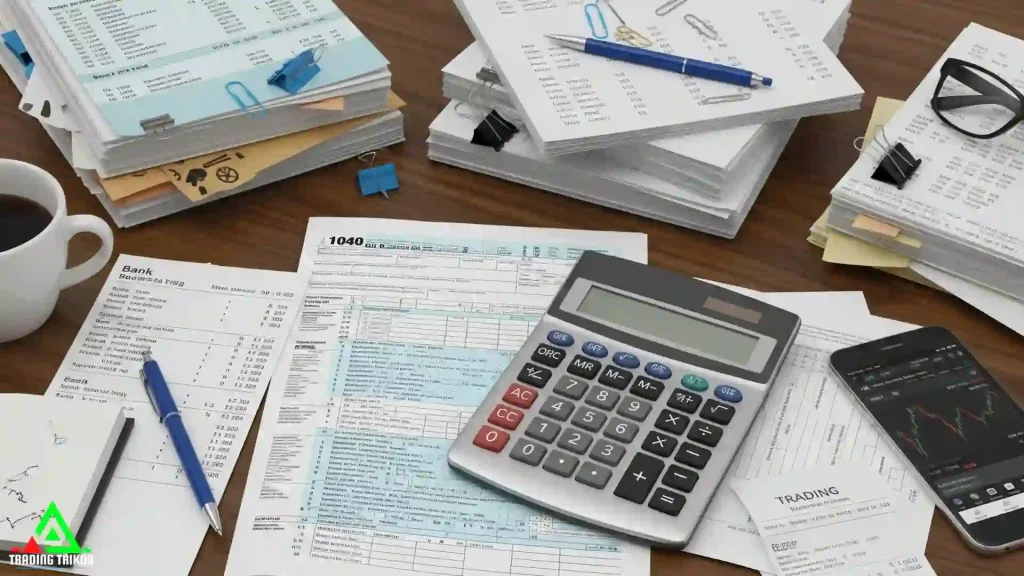Imagine turning a quick profit on a hot stock pick, only to watch a chunk of your gains vanish come tax time. If you’re dipping into short-term trading—buying and selling assets like stocks, cryptocurrencies, or options within a year—you’re likely facing steeper tax bills than long-term investors. But don’t worry; understanding the rules can help you stay ahead, minimize surprises, and even trim your liability.
In this in-depth guide, we’ll break down everything you need to know about handling taxes on short-term trading, from the basics to real-world examples and smart strategies. Whether you’re a day trader juggling dozens of positions or an occasional swing trader, mastering these concepts could save you thousands.
What Is Short-Term Trading and Why Do Taxes Matter?
Short-term trading involves buying and selling financial assets with the goal of profiting from quick price movements, typically holding positions for days, weeks, or months—but always less than a full year. This could include day trading (closing all positions by the end of the day), swing trading (holding for a few days to weeks), or scalping (ultra-short trades for tiny gains).
Taxes enter the picture because profits from these trades are classified as short-term capital gains. Unlike long-term gains, which enjoy preferential rates, short-term gains are taxed at your ordinary income tax rate. This can push your effective rate as high as 37%, depending on your overall income. Ignoring this could lead to underpayment penalties or missed opportunities to offset losses. Plus, with the IRS cracking down on investment reporting through broker-provided 1099 forms, accuracy is non-negotiable. Getting it right not only keeps you compliant but also empowers you to make smarter trading decisions.
Understanding Short-Term Capital Gains Taxes
At its core, a capital gain occurs when you sell an asset for more than you paid (your cost basis). For short-term trades, the holding period is key: If you’ve owned the asset for one year or less, it’s short-term. (Count from the day after acquisition to the sale date.)
Short-term gains are added to your regular income—like wages or interest—and taxed accordingly. This contrasts with long-term gains (over one year), which max out at 20% for most people. Exceptions exist for certain assets, like collectibles (taxed up to 28%), but for standard trades in stocks or ETFs, ordinary rates apply.

Net short-term gains (after subtracting losses) can also trigger additional taxes, such as the 3.8% Net Investment Income Tax (NIIT) if your modified adjusted gross income exceeds $200,000 (single) or $250,000 (married filing jointly). Always factor this in for high earners.
Current USA Tax Rates for Short-Term Gains in 2025
Tax rates on short-term gains follow the federal income tax brackets, which are adjusted annually for inflation. For the 2025 tax year (income earned in 2025, filed in 2026), here are the brackets:
| Tax Rate | Single Filers | Married Filing Jointly | Head of Household |
| 10% | $0 – $11,925 | $0 – $23,850 | $0 – $17,000 |
| 12% | $11,926 – $48,475 | $23,851 – $96,950 | $17,001 – $64,850 |
| 22% | $48,476 – $103,350 | $96,951 – $206,700 | $64,851 – $103,350 |
| 24% | $103,351 – $197,300 | $206,701 – $394,600 | $103,351 – $197,300 |
| 32% | $197,301 – $250,525 | $394,601 – $501,050 | $197,301 – $250,500 |
| 35% | $250,526 – $626,350 | $501,051 – $751,600 | $250,501 – $626,350 |
| 37% | $626,351+ | $751,601+ | $626,351+ |
These rates apply to your total taxable income, including short-term gains. For example, if you’re single with $80,000 in wages and $20,000 in short-term gains, your total $100,000 income would straddle the 22% bracket, meaning part of your gains gets taxed at 12% and the rest at 22%.
Remember, state taxes may add another layer—rates vary from 0% in states like Florida to over 13% in California. Check your state’s rules for a full picture.
How to Report Short-Term Trading Taxes
Reporting starts with your broker’s Form 1099-B, which details all trades, proceeds, and cost basis. Use this to fill out IRS forms accurately.
Step 1: Form 8949 – Sales and Other Dispositions of Capital Assets
This form lists each transaction individually. Part I is for short-term trades.
- Columns to Fill:
- (a) Description of property (e.g., “100 shares XYZ stock”)
- (b) Date acquired
- (c) Date sold
- (d) Proceeds (sales price)
- (e) Cost or other basis
- (f) Adjustments (e.g., for wash sales)
- (g) Gain or loss (d minus e, plus/minus f)
Group transactions by whether the basis was reported to the IRS (Boxes A, B, or C). If you have many trades, software like TurboTax can import data directly.
Sample Entry on Form 8949 (Hypothetical):
Imagine you bought 50 shares of ABC Corp on March 15, 2025, for $2,000 ($40/share) and sold them on July 20, 2025, for $2,500 ($50/share). Gain: $500.
| Column | Entry |
| (a) | 50 sh ABC |
| (b) | 03/15/2025 |
| (c) | 07/20/2025 |
| (d) | $2,500 |
| (e) | $2,000 |
| (f) | $0 |
| (g) | $500 |
Totals from all entries go to Schedule D.
Step 2: Schedule D – Capital Gains and Losses
This summarizes your Form 8949 data. Part I covers short-term totals.
- Line 1a-1b: Enter totals from Form 8949.
- Line 7: Net short-term gain or loss.
- Combine with long-term in Part III for overall net gain/loss.
- If losses exceed gains by more than $3,000 ($1,500 if married filing separately), carry over the excess to future years.
Attach both forms to your Form 1040. If you’re a frequent trader, consider electing “trader tax status” for mark-to-market accounting, which treats gains/losses as ordinary income and allows business expense deductions (file Form 3115 by the due date of your prior year’s return).
Real-World Examples of Short-Term Trading Taxes
Let’s make this concrete with scenarios.
Example 1: Basic Day Trade
You’re single, earning $60,000 from your job. In 2025, you day trade stocks, netting $10,000 in short-term gains after losses.
- Total income: $70,000.
- Bracket: Mostly 22% (after standard deduction of $15,000, taxable income ~$55,000).
- Tax on gains: About $2,200 (22% of $10,000).
- Tip: If losses were $12,000 instead, deduct $3,000 this year, carry over $9,000.
Example 2: High-Earner Swing Trade
Married couple filing jointly, $300,000 combined wages. They swing trade options, realizing $50,000 short-term gains.
- Total income: $350,000.
- Bracket: 24% for most, pushing into 32%.
- Tax on gains: Roughly $15,000 (blended rate), plus potential NIIT of $1,900 (3.8%).
- Strategy: Offset with $20,000 in harvested losses from underperforming positions.
Example 3: Crypto Scalping Loss
You scalp Bitcoin, incurring $8,000 net short-term losses.
- Deduct $3,000 against other income.
- Carry over $5,000 to offset future gains.
- No tax owed on losses, but they reduce your overall bill.
These examples highlight how income level and net position dictate your tax hit.
Strategies to Minimize Taxes on Short-Term Trading

While short-term trades inherently face higher rates, savvy moves can soften the blow:
- Hold Longer When Possible: Aim to cross the one-year mark for long-term rates (0-20%).
- Tax-Loss Harvesting: Sell losing positions to offset gains. Replace with similar (but not identical) assets to avoid wash sale rules (disallowing losses if you repurchase within 30 days).
- Use Tax-Advantaged Accounts: Trade in IRAs or 401(k)s where gains grow tax-free or deferred.
- Manage Your Bracket: Time sales to stay in a lower bracket, or bunch gains in low-income years.
- Elect Trader Status: If you trade full-time (hundreds of trades/year, no other job), deduct home office, software, and education as business expenses. Gains become ordinary, but losses are fully deductible.
- Contribute to Retirement: Max out contributions to lower taxable income overall.
- Charitable Donations: Donate appreciated assets to charity instead of selling—avoid gains tax and get a deduction.
Always consult a tax pro, as rules like the straddle loss deferral or Section 475 elections have nuances.
Common Mistakes to Avoid
- Ignoring Wash Sales: Buying back too soon nullifies loss deductions.
- Forgetting Basis Adjustments: Include commissions or fees in your cost basis.
- Underestimating Estimated Taxes: Pay quarterly if gains exceed $1,000 to avoid penalties.
- Missing Carryovers: Track unused losses—they don’t expire.
- Not Reviewing 1099-B: Errors here lead to IRS notices.
Final Thoughts: Take Control of Your Trading Taxes
Navigating taxes on short-term trading doesn’t have to be a headache. By grasping the rates, mastering reporting with Forms 8949 and Schedule D, and applying offset strategies, you can keep more of your hard-earned profits. Start by reviewing your 2025 trades early, use reliable software, and consider professional advice for complex portfolios. The key? Stay informed and proactive—your future self (and wallet) will thank you. Ready to optimize your next trade? Dive deeper into your broker’s tools today.
What is a short-term capital gain, and how is it taxed?
A short-term capital gain is a profit from selling an asset held for one year or less. These gains are typically taxed at your ordinary income tax rate, which is often higher than long-term capital gains rates. The specific tax bracket depends on your total taxable income.
How is day trading income classified for tax purposes?
Day trading profits are generally classified as speculative business income rather than capital gains. This means they are taxed at your regular income tax slab rates, and you may be able to deduct business-related expenses.
What is the “wash sale” rule and how does it affect me?
The wash sale rule prevents you from claiming a capital loss on a security if you repurchase the same or a “substantially identical” security within 30 days before or after the sale. If you do, the loss is disallowed for tax purposes, but the cost basis of the new shares is adjusted.
Can I use my short-term trading losses to offset gains?
Yes, short-term losses can be used to offset both short-term and long-term capital gains. If your total losses exceed your total gains for the year, you can deduct up to $3,000 of the excess loss against your ordinary income, and carry forward the rest.
What tax forms do I need to file for short-term trading?
For most individual investors, short-term trading activities are reported on Form 8949 and Schedule D. If your trading is classified as a business, you would file an ITR form for business income and report your earnings there.


